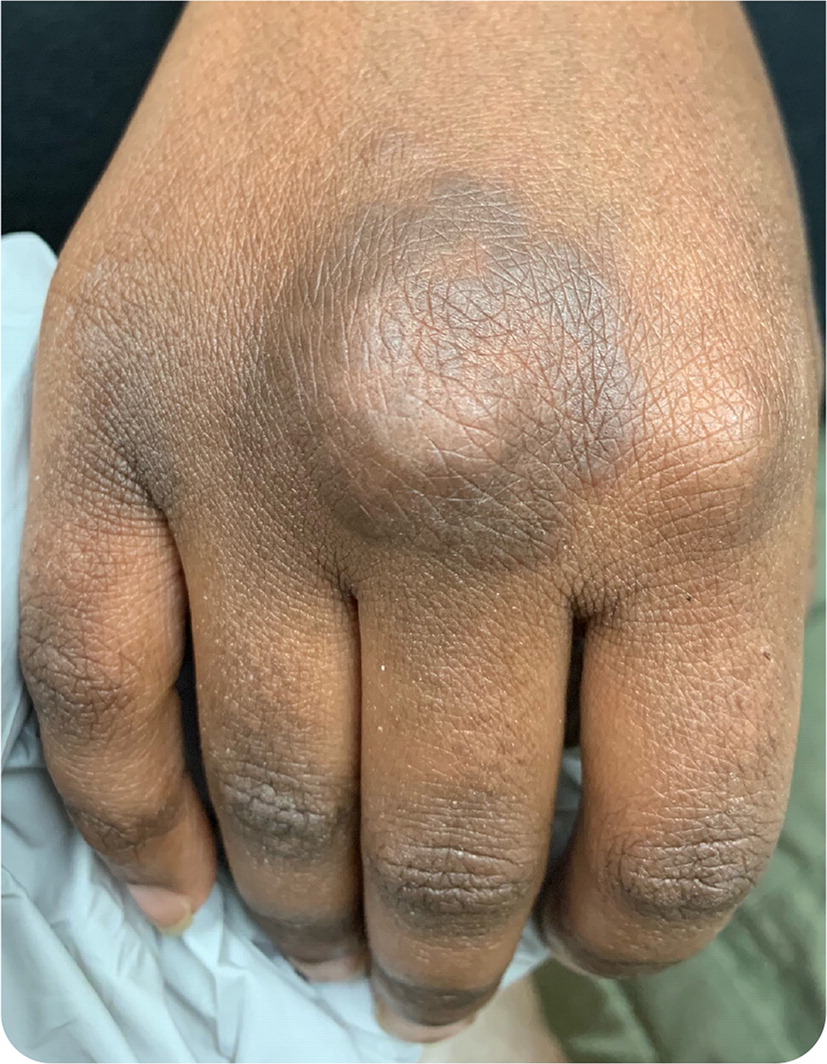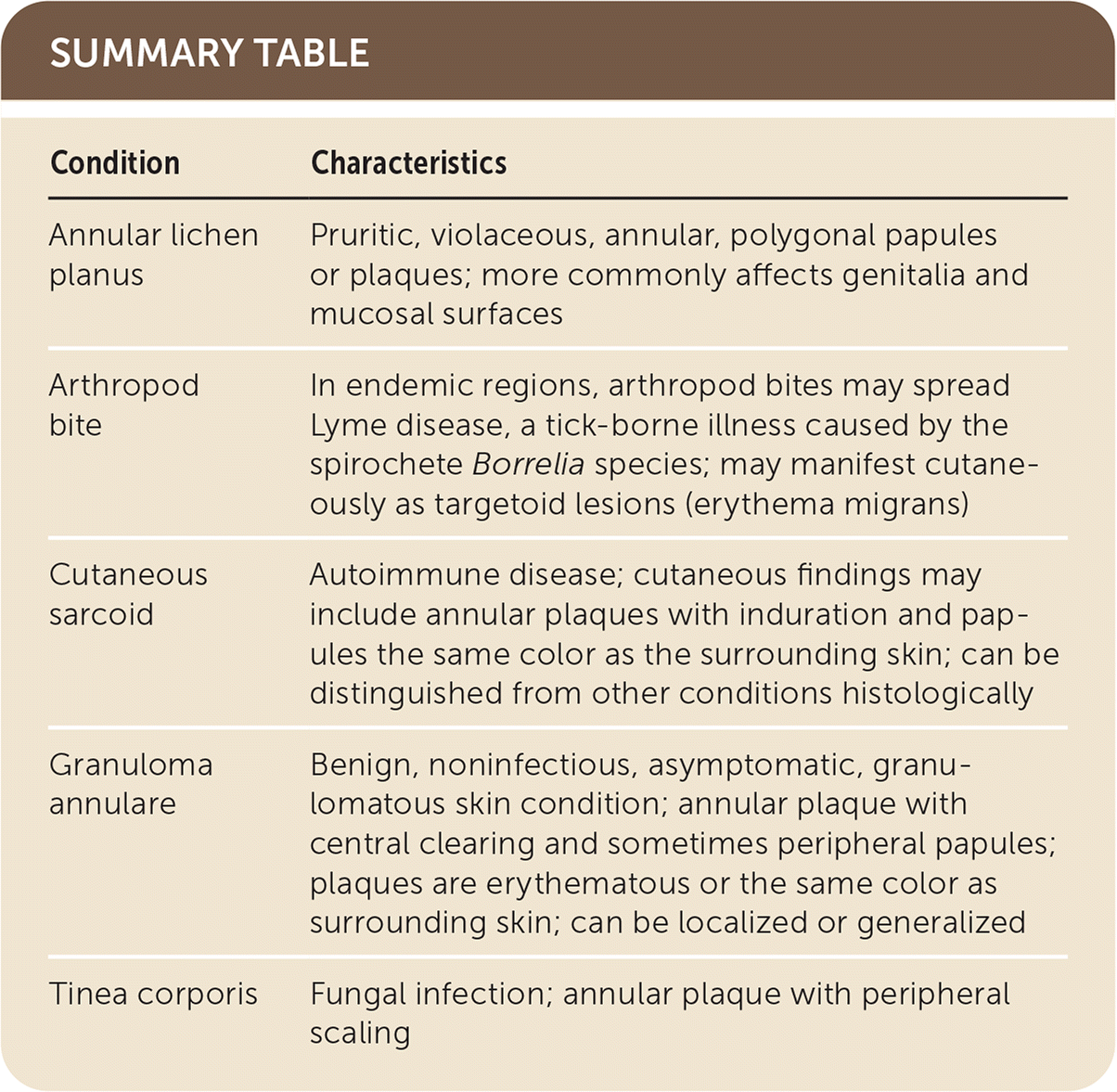
Am Fam Physician. 2022;106(1):85-86
Author disclosure: No relevant financial relationships.
A 26-year-old woman presented with mildly tender, circular, hyperpigmented skin lesions with small bumps affecting the dorsum of both hands (Figure 1) and the medial aspect of the left foot. The lesions, which were first noticed approximately five months earlier, had an insidious onset and grew slowly. There was no pruritus or drainage.

The patient had mild arthralgias in her hands and feet. She had no recent travel or exposure to wilderness areas. She had a history of tobacco use. Laboratory workup was negative for inflammation.
Question
Based on the patient’s history and physical examination findings, which one of the following is the most likely diagnosis?
A. Annular lichen planus.
B. Arthropod bite.
C. Cutaneous sarcoid.
D. Granuloma annulare.
E. Tinea corporis.
Discussion
The answer is D: granuloma annulare, a benign, noninfectious, asymptomatic, granulomatous skin condition. Although the pathogenesis is unclear, it is theorized to be related to a hyper-sensitivity reaction. Iatrogenic processes such as drug reactions and bacterial and viral exposures may be associated triggers.1 Granuloma annulare is more common in women and individuals younger than 30 years. A form of granuloma annulare presenting as subcutaneous nodules is more common in children.2
Granuloma annulare can be localized or generalized and most commonly affects the hands or feet. Several variants have been reported. The most prevalent localized variant features annular plaques with central clearing and sometimes peripheral papules. The plaques are erythematous or the same color as surrounding skin. The generalized variant is defined by the presence of 10 or more of these characteristic lesions. Diagnosis of granuloma annulare is clinical, although a punch biopsy may help differentiate it from other granulomatous skin disorders.3 Abundant mucin deposition is characteristic on histopathology. Another histologic feature is collagen degeneration surrounded by lymphocytes and histiocytes in an interstitial, palisading, or rarely epithelioid nodule pattern.2
Localized granuloma annulare is self-limited; however, topical or intralesional corticosteroids may be beneficial if treatment is needed for cosmetic reasons.3 The generalized form is more prone to relapse and less likely to resolve spontaneously.1 Systemic corticosteroids are typically required, but biologic therapies, such as tumor necrosis factor-alpha inhibitors, have shown promise in patients with generalized granuloma annulare.1
Annular lichen planus is characterized by pruritic, violaceous, annular, polygonal papules or plaques. This condition more commonly affects genitalia and mucosal surfaces.
In endemic regions, arthropod bites may spread Lyme disease, a tick-borne illness caused by the spirochete Borrelia species. Lyme disease can manifest cutaneously as targetoid lesions (erythema migrans). Patients with erythema migrans associated with Lyme disease typically have a history of travel to an endemic region and are likely to develop additional symptoms and progressive illness.
Cutaneous sarcoid is an autoimmune disease that may present cutaneously as annular plaques with induration and papules the same color as the surrounding skin. Cutaneous sarcoid most commonly involves the shoulders and back. It can be distinguished from other conditions histologically.
Tinea corporis is a fungal infection that presents as an annular plaque. Tinea corporis is associated with scaling, particularly around the periphery of the lesion, and is often pruritic.

| Condition | Characteristics |
|---|---|
| Annular lichen planus | Pruritic, violaceous, annular, polygonal papules or plaques; more commonly affects genitalia and mucosal surfaces |
| Arthropod bite | In endemic regions, arthropod bites may spread Lyme disease, a tick-borne illness caused by the spirochete Borrelia species; may manifest cutaneously as targetoid lesions (erythema migrans) |
| Cutaneous sarcoid | Autoimmune disease; cutaneous findings may include annular plaques with induration and papules the same color as the surrounding skin; can be distinguished from other conditions histologically |
| Granuloma annulare | Benign, noninfectious, asymptomatic, granulomatous skin condition; annular plaque with central clearing and sometimes peripheral papules; plaques are erythematous or the same color as surrounding skin; can be localized or generalized |
| Tinea corporis | Fungal infection; annular plaque with peripheral scaling |
The views expressed are those of the authors and do not represent the official policy of the U.S. Army Medical Department, the Department of Defense, or the U.S. government.
